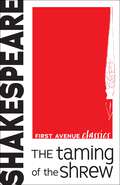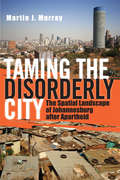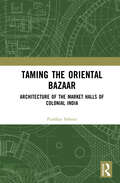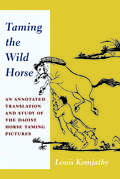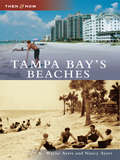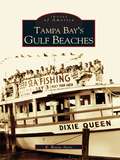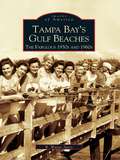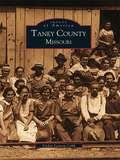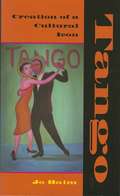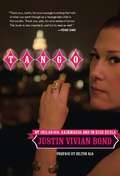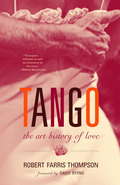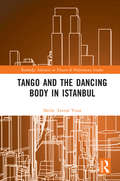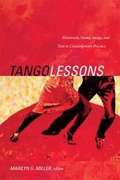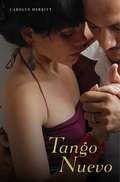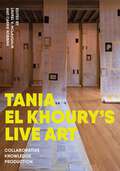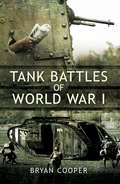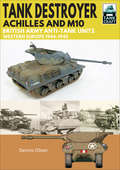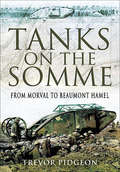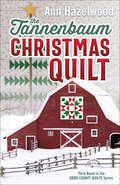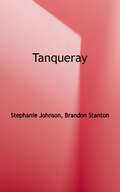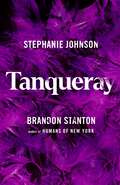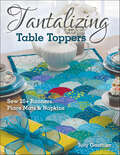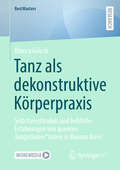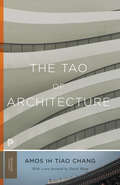- Table View
- List View
The Taming of the Shrew: Being The Original Of Shakespeare's 'taming Of The Shrew' Edited (classic Reprint) (First Avenue Classics ™)
by William ShakespeareLucentio comes to Padua to attend the university, but his attention is quickly captured by the lovely Bianca. He would do anything to marry her, including disguise himself as her Latin teacher. But a major obstacle stands in the way of Lucentio's intentions: Bianca's father will only allow Bianca to marry after her sister, Katherine, is married. Katherine is everything Bianca is not. She is ill-tempered, opinionated, and objects to the idea of marriage. When bold Petruchio arrives in Padua, however, he might just be the kind of suitor who could succeed in marrying Katherine. This is an unabridged version of English playwright William Shakespeare's romantic comedy, which was first published in 1623.
Taming the Disorderly City: The Spatial Landscape of Johannesburg after Apartheid
by Martin J. MurrayIn postapartheid Johannesburg, tensions of race and class manifest themselves starkly in struggles over "rights to the city." Real-estate developers and the very poor fight for control of space as the municipal administration steps aside, almost powerless to shape the direction of change. Having ceded control of development to the private sector, the Johannesburg city government has all but abandoned residential planning to the unpredictability of market forces. This failure to plan for the civic good—and the resulting confusion—is a perfect example of the entrepreneurial approaches to urban governance that are sweeping much of the Global South as well as the cities of the North.Martin J. Murray brings together a wide range of urban theory and local knowledge to draw a nuanced portrait of contemporary Johannesburg. In Taming the Disorderly City, he provides a focused intellectual and political critique of the often-ambivalent urban dynamics that have emerged after the end of apartheid. Exploring the behaviors of the rich and poor, each empowered in their own way, as they rebuild a new Johannesburg, we see the entrepreneurial city: high-rises, shopping districts, and gated communities surrounded by and intermingled with poverty. In graceful prose, Murray offers a compelling portrait of the everyday lives of the urban poor as seen through the lens of real-estate capitalism and revitalization efforts.
Taming the Oriental Bazaar: Architecture of the Market-Halls of Colonial India
by Pushkar SohoniTaming the Oriental Bazaar examines the public market-hall as a key architectural feature of colonial South Asia. Representing a transition in the architectural programme, these buildings were meant to be monuments and markers of modernity in South Asia. The book: • Explores how market-halls became an essential feature of colonial settlements from the mid-nineteenth through the mid-twentieth centuries; • Discusses public health policies and legislations central to the concerns of market-hall sanitation; • Reviews the elements of modernity, including institutions and systems established in the nineteenth century as India went from Company to Crown; • Studies the specific circumstances and histories of market halls in the towns and cities of Bengaluru, Vadodara, Mumbai, Kolkata, Hyderabad, Karachi, Lahore, Chennai, Pune, and others. A key text in the study of colonial architecture, this book will be of interest to students, researchers as well as general readers of architecture, colonialism, history of architecture, history of medicine, public health, urbanism, and South Asian studies.
Taming the Wild Horse: An Annotated Translation and Study of the Daoist Horse Taming Pictures
by Louis KomjathyIn thirteenth-century China, a Daoist monk named Gao Daokuan (1195-1277) composed a series of illustrated poems and accompanying verse commentary known as the Daoist Horse Taming Pictures. In this annotated translation and study, Louis Komjathy argues that this virtually unknown text offers unique insights into the transformative effects of Daoist contemplative practice. Taming the Wild Horse examines Gao's illustrated poems in terms of monasticism and contemplative practice, as well as the multivalent meaning of the "horse" in traditional Chinese culture and the consequences for both human and nonhuman animals.The Horse Taming Pictures consist of twelve poems, ten of which are equine-centered. They develop the metaphor of a "wild" or "untamed" horse to represent ordinary consciousness, which must be reined in and harnessed through sustained self-cultivation, especially meditation. The compositions describe stages on the Daoist contemplative path. Komjathy provides opportunities for reflection on contemplative practice in general and Daoist meditation in particular, which may lead to a transpersonal way of perceiving and being.
Tampa Bay's Beaches
by Nancy Ayers R. Wayne AyersThe pace of redevelopment has accelerated in recent years along Tampa Bay's gulf beaches, leaving tourists and residents alike in awe. This volume provides a glimpse at the beaches as they were and as they are today, and opens a whole new window to view the development that both enhances and threatens the barrier islands. Author R. Wayne Ayers and photographer Nancy Ayers, residents of Belleair Beach, are actively involved in chronicling and preserving the area's past.
Tampa Bay's Gulf Beaches
by R. Wayne AyersTampa Bay's Gulf Beaches follows the fascinating development of the beach strip along the Gulf of Mexico, from Pass-a-Grille to Clearwater Beach, from its early settlement in the late 1800s until its blossoming as a tourist haven after World War II. This famous beach strip is the pride of residents and a premier destination for beach lovers worldwide with its miles of white sand and glorious sunsets. History shows that just a century ago the strip was largely a vast wilderness visited primarily by fishermen and a few adventurous bathers and sightseers. Over the years, curiosity gradually gave way to an abiding affinity for these beautiful beaches and towns that sprang up along the shore.Through vintage postcards and photos, a diverse group of people and places are shown as they actually appeared-sportsmen and their "catches;" bathers whose attire evolved from bloomers and formal dress to one-piece bathing suits; the early "swing" and rickety wooden bridges; rustic frame hotels giving way to modern motels; the "downtown" areas of Indian Rocks Beach, Pass-a-Grille, Madeira Beach, and Clearwater Beach; plus casinos, bathhouses, waterslides, a Grand Hotel, and much more.
Tampa Bay's Gulf Beaches: The Fabulous 1950s and 1960s
by R. Wayne AyersIn the years following World War II, Tampa Bay's barrier island beaches were transformed from a sparsely populated strip to a booming vacation destination. Following the war's end, fond memories of beachside training exercises amid sand and sea attracted thousands of former G.I.s and their families to the area for vacation. This sudden outbreak of tourism caught the attention of developers, who quickly converted the lonely stretches of beach into a vacationer's paradise, complete with snazzy motels offering the latest amenities. Once home to fishermen and well-to-do winter vacationers, the area's gulf beaches became a popular getaway for newly prosperous middle-class families, anxious to put war-weary years behind them.
Taney County, Missouri
by Vickie Layton CobbTaney County, Missouri obtained its name from Roger B. Taney, who married Anne Key, sister of the author of America's national anthem, Francis Scott Key. With roots already embedded in Americana, this once fledgling area in southwestern Missouri would become home to hearty pioneers and entrepunearal miners, who would, over the centuries, transform it into the major tourist region it is today.Captured here in almost 200 vintage photographs are the lives and spirits of those souls who founded Taney County and fostered its growth throughout the years. These images span two centuries to include the pioneers and early farming families of the 19th century, as well as the hometown heroes of the World Wars. Pictured here are the one-room school houses, early photos of life on the Buffalo and White Rivers, the miners of the Turkey Creek Mining Company, and various events and residents of Kirbyville, Oak Grove, Mildred, and Branson, also known as the Nashville of the Ozarks.
Tango: Creation of a Cultural Icon
by Jo BaimIn Tango: Creation of a Cultural Icon Jo Baim dispels common stereotypes of the tango and tells the real story behind this rich and complex dance. Despite its exoticism, the tango of this time period is a very accessible dance, especially as European and North American dancers adapted it. Modern ballroom dancers can enjoy a "step" back in time with the descriptions included in this book. Almost as interesting as the history of the tango is the cultural response to it: cities banned it, army officers were threatened with demotion if caught dancing it, clergy and politicians wrote diatribes against it. Newspaper headlines warned that people died from dancing the tango and that it would be the downfall of civilization. The vehemence of these anti-tango outbursts confirms one thing: the tango was a cultural force to be reckoned with!
Tango: My Childhood, Backwards and in High Heels
by Justin Vivian BondWINNER OF A 2012 LAMBDA LITERARY AWARD"Like Bond, the memoir is droll, pensive and filled with zingers teetering between funny and ferocious."-The New York Times"Bond's fabulosity is matched by a trenchant wit, and [V's] over-the-top stories are smartly edged with politics, sexual or otherwise."-The New York TimesRecently hailed as "the greatest cabaret artist of [V's] generation" in The New Yorker, Mx. Justin Vivian Bond makes a brilliant literary debut with this staggeringly candid and hilarious novella-length memoir.With a recent diagnosis of attention deficit disorder, and news that V's first lover from childhood has been imprisoned for impersonating an undercover police officer, Bond recalls in vivid detail coming of age as a trans kid. Always haunted by the knowledge of being "different," Bond was further confused when the bully next door wanted to meet secretly. Their trysts went on for years, and made Bond acutely aware of sexual power and vulnerability. With inimitable style, Bond raises issues about LGBTQ adolescence, homophobia, parenting, and sexuality, while being utterly entertaining.Singer, songwriter, and Tony-nominated performance artist Mx. Justin Vivian Bond is an Obie, Bessie, and Ethyl Eichelberger Award winner. As one half of the performance duo Kiki and Herb, Bond has toured the world, headlining at Carnegie Hall, the Sydney Opera House, and London's Queen Elizabeth Hall, and starring in a Tony nominated run on Broadway, Kiki and Herb Alive on Broadway. Film credits include a role in John Cameron Mitchell's feature Shortbus. Bond has recently released two records, Dendrophile, and Silver Wells.
Tango: The Art History of Love
by Robert Farris ThompsonIn this generously illustrated book, world- renowned Yale art historian Robert Farris Thompson gives us the definitive account of tango, “the fabulous dance of the past hundred years—and the most beautiful, in the opinion of Martha Graham. ” From its syncretic evolution in the nineteenth century—partaking of European, Andalusian-Gaucho, and, unbeknownst to many, African influences—to its representations by Hollywood and dramatizations in dance halls throughout the world, Thompson shows us tango not only as brilliant choreography but also as text, music, art, and philosophy of life. As he did in his classic Flash of the Spirit: African and Afro-American Art and Philosophy, Thompson, in this book, “takes his subject in the round, not in any specialized or compartmentalized manner. He is part anthropologist, part art critic, part musicologist, part student of religion and philosophy, and entirely an enthusiastic partisan of what he writes about” (The New York Times). Passionately argued; unparalleled in its research, its synthesis, and its depth of understanding; and written with revelatory clarity, Tango: The Art History of Love is a monumental achievement.
Tango and the Dancing Body in Istanbul (Routledge Advances in Theatre & Performance Studies)
by Melin Levent YunaTango and the Dancing Body in Istanbul explores the expansion of social Argentine tango dancing among Muslim actors in Turkey, pioneered in Istanbul despite the conservative rule of the Justice and Development Party (JDP) and Tayyip Erdoğan. In this book, Melin Levent Yuna questions why a dance that appears to publicly represent an erotic relationship finds space to expand and increase dramatically in the number of contemporary Turkish Muslim tango dancers, particularly during a conservative rule. Even during the 2020 Covid-19 pandemic, tango dance classes, gatherings, and messages flourished on YouTube, Facebook, Instagram, and Zoom. Urban Turkey and its tango dance performances provide one symbol and example of how neoliberal capitalism could go hand in hand with conservatism by becoming a bridge between Europe and the Middle East. This study largely focuses on the dancers’ perspective while presenting the policies of Erdoğan. It presents the social characteristics of the tango dancers, the meanings they attach to their bodies and their dance as well as what this dance reflects about them – besides the policies of the Justice and Development Party. The book approaches the tango dance and its dancing body in terms of layers of meaning systems in a neoliberal and conservative context. This study will be of great interest to students and scholars in dance, anthropology, cultural studies, and performance studies.
Tango Lessons: Movement, Sound, Image, and Text in Contemporary Practice
by Marilyn G. MillerFrom its earliest manifestations on the street corners of nineteenth-century Buenos Aires to its ascendancy as a global cultural form, tango has continually exceeded the confines of the dance floor or the music hall. In Tango Lessons, scholars from Latin America and the United States explore tango's enduring vitality. The interdisciplinary group of contributors--including specialists in dance, music, anthropology, linguistics, literature, film, and fine art--take up a broad range of topics. Among these are the productive tensions between tradition and experimentation in tango nuevo, representations of tango in film and contemporary art, and the role of tango in the imagination of Jorge Luis Borges. Taken together, the essays show that tango provides a kaleidoscopic perspective on Argentina's social, cultural, and intellectual history from the late nineteenth to the early twenty-first centuries.Contributors. Esteban Buch, Oscar Conde, Antonio Gómez, Morgan James Luker, Carolyn Merritt, Marilyn G. Miller, Fernando Rosenberg, Alejandro Susti
Tango Nuevo
by Carolyn MerrittThe Argentine tango is one of the world’s best-known partner dances. Though tango is much admired and discussed, very little has been written on its ongoing evolution. In this innovative work, Carolyn Merritt surveys tango history while focusing on the most recent iteration of the dance, tango Nuevo, and the práctica scene that has exploded in Buenos Aires since the early 2000s.After starting with an overview of tango, Merritt leads readers on a great adventure through the traditional dance halls and the less formal prácticas of Buenos Aires to tango communities on both coasts of the United States. Along the way, Merritt’s personal observations show the dance’s emotional depth and the challenges dancers face in tango venues old and new. Her investigation also demonstrates how innovation, globalization, and fusion, which many associate with nuevo, have always been at work in tango.Combining sensuous prose, provocative images, and often heartbreaking stories, this book takes an unflinching look at the complex motivations driving the pursuit to master this intricate dance. Throughout, Merritt questions the "newness" of Nuevo through portraits of machismo, violence, and elitism in contemporary tango. The result is a volume that highlights the tensions between preservation and evolution of this--or any--cultural art form.Members of the global tango community as well as students of dance, folklore, anthropology, and the social sciences will embrace this book. For those who are devoted to Argentine tango as dance, this book will be indispensable to understanding its most recent transformations.
Tania El Khoury's Live Art: Collaborative Knowledge Production
by Carrie RobbinsTania El Khoury’s Live Art is the first book to examine the work of Tania El Khoury, a “live” artist deeply engaged in the politics and histories of the South West Asia and North Africa (SWANA) region. Since the 2011 Syrian uprisings, El Khoury has conceived and created works about lived experiences at and across international borders in collaboration with migrants, refugees, and displaced persons as well as other artists, performers, and revolutionaries. All of El Khoury’s works cross borders: between forms of artistic practice, between artists and audiences, and between art and activism. Facilitating critical dialogue about the politics of SWANA and the impact of globalization, her performances and installations also test the boundaries of aesthetic, political, and everyday norms. This interdisciplinary and multimedia reader features essays by artists, curators, and scholars who explore the dynamic possibilities and complexities of El Khoury’s art. From social workers to archeologists to archivists, contributing authors engage with the radical epistemological and political revolutions that El Khoury and her collaborators invite us all to join.
Tank Battles of World War I
by Bryan CooperFailure to exploit the potential of an original idea is a recurring phenomenon in our national history. Few failures, however, can have been so costly in human life as that of our military commanders early in 1916 to appreciate that the tank was a war winning weapon. The slaughter of the Somme, Passchendaele and Ypres salient had to be endured before accepted 'conventional' methods were abandoned and the tank given a chance. Bryan Cooper describes the early tank actions in vivid detail, with many eye-witness accounts. He tells of the courage and endurance of the crews not just in battle but in the appalling conditions in which they had to drive and fight their primitive vehicles. Scalded, scorched and poisoned with exhaust fumes, constantly threatened with being burned to death, these crews eventually laid the foundation for the Allied Victory in World War I. The book is well illustrated with many original photographs which give the present day reader a glimpse of the infancy of a dominant weapon of modern war.
Tank Destroyer, Achilles and M10: British Army Anti-Tank Units, Western Europe, 1944–1945 (TankCraft)
by Dennis OliverA guide that blends the history behind this British World War II tank with resources for military vehicle modeling enthusiasts. In this heavily illustrated volume in the TankCraft series Dennis Oliver focuses on the Achilles—the British variant of the American M10—which was one of the most important Allied tank destroyers of the Second World War. It played a key role in the armored battles fought on the Western Front, in particular in France, the Low Countries, Germany and Italy. Built on an adapted Sherman chassis, with sloped armor, an open-topped turret and powerful 17-pounder gun, it was designed to counter the threat posed by the formidable panzers deployed by the German army toward the end of the conflict, in particular the Panther and Tiger tanks. The book covers the design and operational history of the Achilles in close detail, using rare archive photographs and meticulously researched color illustrations, as well as a detailed, authoritative text. A key section displays available model kits and aftermarket products, complemented by a gallery of beautifully constructed and painted models in various scales. Technical details as well as modifications introduced during production and in the field are also examined providing everything the modeler needs to recreate an accurate representation of these historic armored fighting vehicles. Praise for Tank Destroyer, Achilles and M10 &“Covers the design and operational history of the Achilles in close detail, using rare archive photographs and meticulously researched color illustrations, as well as a detailed, authoritative text.&” —Military Vehicles &“Gamers will find this book a useful reference and painting guide.&” —The Miniatures Page
Tanks on the Somme: From Morval to Beaumont Hamel
by Trevor PidgeonOn 15 September 1916 during the Battle of the Somme, tanks - one of the decisive weapons of twentieth-century warfare - were sent into action for the first time. In his previous books Trevor Pidgeon, one of the leading authorities on the early tanks, has told the story of that memorable day, but only now has his account of later tank operations during the Somme battle become available. In this, his last work which was completed shortly before he died, he reconstructs the tank actions that took place between late September and November when the Somme offensive was closed down. His account gives a vivid insight into the actions and experiences of the tank crews, and it shows the appalling dangers they faced as they maneuvered their crude, vulnerable and unreliable machines towards the enemy. His book will be essential reading for anyone who is familiar with his previous studies of the subject and for anyone who wants to follow in the tracks of the tanks as they lumbered across the battlefield nearly 100 years ago.
The Tannenbaum Christmas Quilt: Third Novel In The Door County Quilts Series (Door County Quilts Series #3)
by Ann HazelwoodAn artist confronts her former flame and new challenges with her quilt circle in this holiday mystery from the author of the Wine Country Quilt series. Claire Stewart continues her quilt adventures in her little hometown of Fish Creek in Door County, Wisconsin. This time, Claire must face her former lover, Dr. Austen Page, since his terrible accident. How does this awkward moment work out? Her new Door County relationship with the man wearing the red scarf is the first who wants to know. Meanwhile, The Quilters of the Door have a new member, Anna Marie Meyer, who has recently moved from Germany. She brings with her an antique Tannenbaum Christmas quilt that has been in her family for generations. Claire embarks on embracing Anna and a wonderful German Christmas, as well as navigating her complicated love life. Praise for Ann Hazelwood and her novels &“I found myself immersed in the tale of this extended family and this wonderful quaint town . . . You will laugh, cry and share in their hopes and dreams.&” —Community News &“Ann Hazelwood knows a few things about the human spirit, family and dreaming big. Add a mixture of the love of quilting and all the things Missouri historic and otherwise; you will experience the words and passion of this unique and gifted author. Enjoy the experience!&”—StreetScape Magazine
Tanqueray
by Stephanie Johnson Brandon Stanton"A deeply touching memoir . . . A beautiful, sometimes shocking NC-17 story, kept out of the lily-white, upper crust canon of literature--until now."" --The Washington Post The storytelling phenomenon Humans of New York and its #1 bestselling books have captivated a global audience of millions with personal narratives that illuminate the human condition. But one story stands apart from the rest... She is a woman as fabulous, unbowed, and irresistible as the city she lives in. Meet TANQUERAY. In 2019, Humans of New York featured a photo of a woman in an outrageous fur coat and hat she made herself. She instantly captured the attention of millions. Her name is Stephanie Johnson, but she's better known to HONY followers as ""Tanqueray,"" a born performer who was once one of the best-known burlesque dancers in New York City. Reeling from a brutal childhood, immersed in a world of go-go dancers and hustlers, dirty cops and gangsters, Stephanie was determined to become the fiercest thing the city had ever seen. And she succeeded. Real, raw, and unapologetically honest, this is the full story of Tanqueray as told by Brandon Stanton--a book filled with never-before-told stories of Tanqueray's struggles and triumphs through good times and bad, personal photos from her own collection, and glimpses of New York City from back in the day when the name "Tanqueray" was on everyone's lips."
Tanqueray
by Brandon Stanton Stephanie JohnsonThe storytelling phenomenon Humans of New York and its #1 bestselling books have captivated a global audience of millions with personal narratives that illuminate the human condition. But one story stands apart from the rest...She is a woman as fabulous, unbowed, and irresistible as the city she lives in. Meet TANQUERAY.In 2019, Humans of New York featured a photo of a woman in an outrageous fur coat and hat she made herself. She instantly captured the attention of millions. Her name is Stephanie Johnson, but she’s better known to HONY followers as “Tanqueray,” a born performer who was once one of the best-known burlesque dancers in New York City. Reeling from a brutal childhood, immersed in a world of go-go dancers and hustlers, dirty cops and gangsters, Stephanie was determined to become the fiercest thing the city had ever seen. And she succeeded.Real, raw, and unapologetically honest, this is the full story of Tanqueray as told by Brandon Stanton—a book filled with never-before-told stories of Tanqueray's struggles and triumphs through good times and bad, personal photos from her own collection, and glimpses of New York City from back in the day when the name “Tanqueray” was on everyone’s lips.
Tansu: Traditional Japanese Cabinetry
by Ty Heineken Kiyoko HeinekenTansu, the unique cabinetry of Japan, springs from a rich folk-art tradition. This book is lavishly illustrated with 27 full-color plates and over 260 monochrome photographs of spectacular chests and elegant details. It is divided into two parts, the first on history and the second on techniques. It also includes an invaluable guide to purchasing and conserving tansu.
Tantalizing Table Toppers: Sew 20+ Runners, Place Mats & Napkins
by Judy GauthierDinner is served! Table decor to enjoy all year A well-dressed table is just stitches away! Showcase your creativity with handmade table toppers that are equal parts functional and fun. Best-selling author Judy Gauthier shares twenty unique table runners you can display year round, plus coordinating placemats and napkins. Step-by-step instructions are included for each project, with basics on piecing, pressing, and understanding color values. Use the coordinating fast2cut Simple Square Templates for easy blocks that fit together like magic! Try out new patchwork, appliqué, and quilting designs before making a commitment to a full quilt. Makers of all skill levels will love the satisfaction of a quick finish. Table accents for every home! Make dinnertime feel special with a quilted runner Instantly change the look of your kitchen or dining room with over twenty fast, fun, and easy projects Share the love—table decor makes great gifts!
Tanz als dekonstruktive Körperpraxis: Selbstverständnis und leibliche Erfahrungen von queeren Tangotänzer*innen in Buenos Aires (BestMasters)
by Bianca GriechIn der kulturellen Praxis des Tango Argentino wird die Semantik einer Überschneidung hegemonialer Diskurse sichtbar, die insbesondere durch binäre Geschlechterrollen und heteronormative Performanz gekennzeichnet sind. Im Kontext der leidenschaftlichen und emotionalen Begegnungen des Tangos, die nicht selten von erotischen Spannungen durchzogen sind, entfaltet sich ein Diskurs, der die heteronormative Konstruktion der tanzenden Körper vermittelt. Ausgehend von der Betrachtung des Tangos als Bewegungspraxis, die in einem symbolisch-diskursiven Feld verortet ist, das den Konstitutionsrahmen für Körper und deren Bewegungen im Tanz schafft, untersucht die vorliegende Arbeit vor dem Hintergrund der Queer Theory und Ansätzen der feministischen Phänomenologie das Verhältnis zwischen dem Diskurs der Geschlechterdifferenz und der körperlich-leiblichen Erfahrung queerer Tangotänzer*innen. Im Zentrum steht dabei die Frage, auf welche Weise heteronormative Strukturen, die in der Tangokultur vorherrschen, im Sinne queerer Subversion dekonstruiert werden. Das Erkenntnisinteresse dieser Arbeit liegt darin zu verstehen, wie sich queeres Selbstverständnis im Tango manifestiert, in welchen Elementen des Tangos sich Performativität und die diskursive Konstitution von Geschlechterrollen widerspiegeln und wie queere Tangotänzer*innen in Bezug darauf den Tanz auf der körperlichen Ebene erfahren.
The Tao of Architecture
by David Wang Amos Ih ChangFrank Lloyd Wright first noted the affinity between modern Western architecture and the philosophy of the ancient Chinese writer Laotzu. In this classic work, Amos Ih Tiao Chang expands on that idea, developing the parallel with the aid of architectural drawings and Chinese paintings. Now with a new foreword by David Wang, this book reveals the vitality of intangible, or negative, elements. Chang writes that these qualities make architectonic forms "come alive, become human, naturally harmonize with one another, and enable us to experience them with human sensibility." The Tao of Architecture continues to be essential reading for understanding the intersection between architecture and philosophy.
